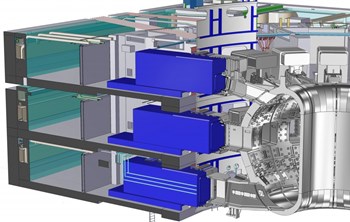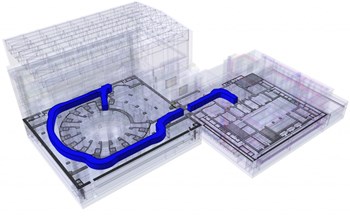
As part of the contract, 15 lorry-sized containers (or ''casks'') will be realized for the sealed transport of components in need of repair or replacement. The casks will travel between the vacuum vessel and the Hot Cell Facility, capable of ''docking'' at three different levels of the machine as shown here.
The European Domestic Agency has awarded a seven-year, EUR 100 million contract to a European consortium for the development, testing and installation of the cask and plug remote handling system—the robotic system at ITER that will ensure the remote transfer of in-vessel components between the vacuum vessel and the Hot Cell Facility for maintenance or disposal.

The cask and plug remote handling system is challenging to design due to the limited space in the environment of the tokamak, complex trajectories over multiple levels, and a nuclear environment. In blue: a sample trajectory between the Tokamak Building (left) and the Hot Cell Facility.
The consortium members bring a wide range of experience in the design and realization of automated systems, the supply of nuclear equipment, mechanical engineering, project management, remote handing and robotics, air cushion technology, and engineering design. The consortium is formed by Airbus Safran Launchers (France-Germany), Nuvia Limited (UK) and Cegelec CEM (VINCI Energy, France), with the support of the UK Atomic Energy Authority (UKAEA), the Instituto Superio Técnico (IST, Portugal), AVT Europe NV (Belgium) and Millennium (France). 







